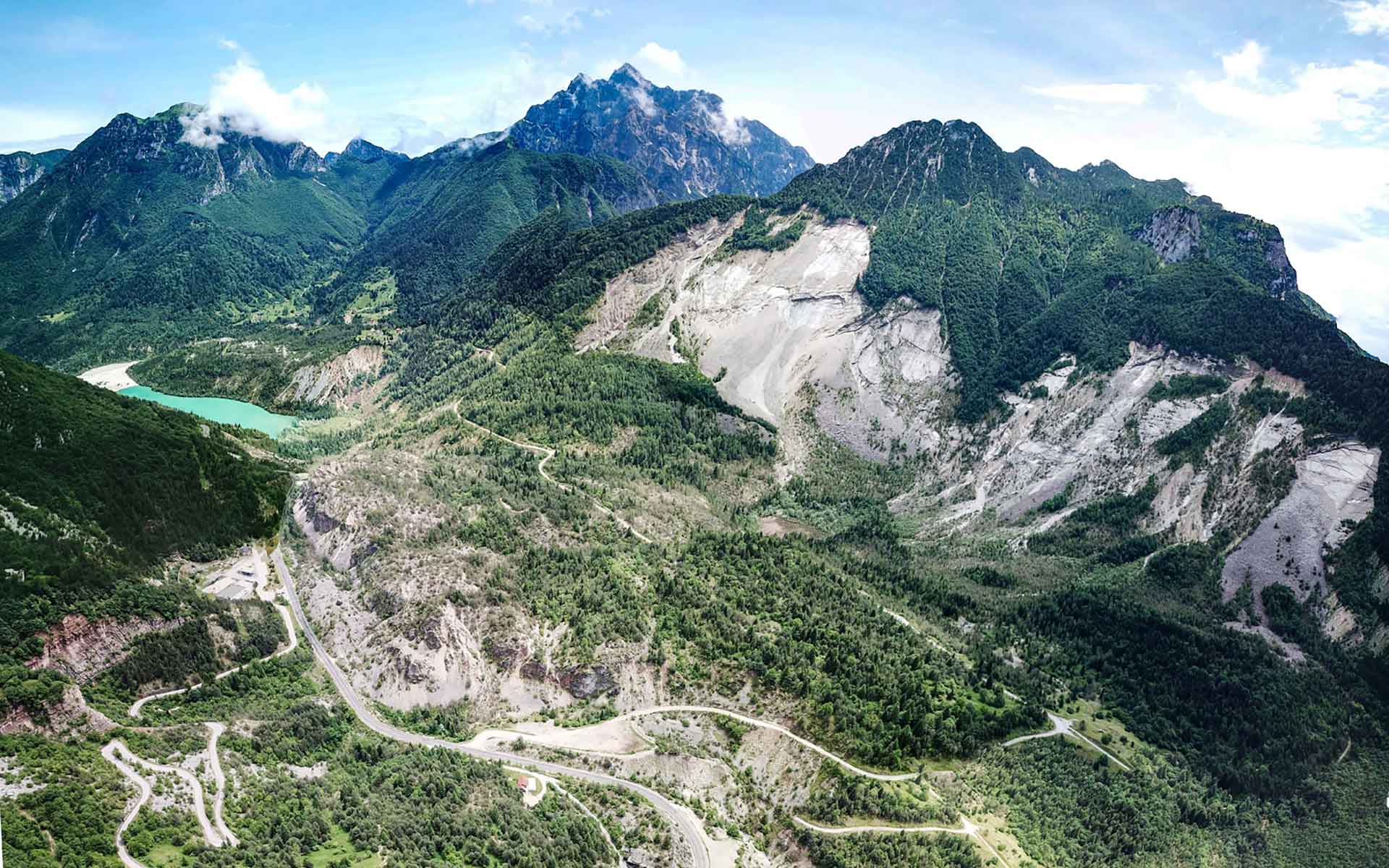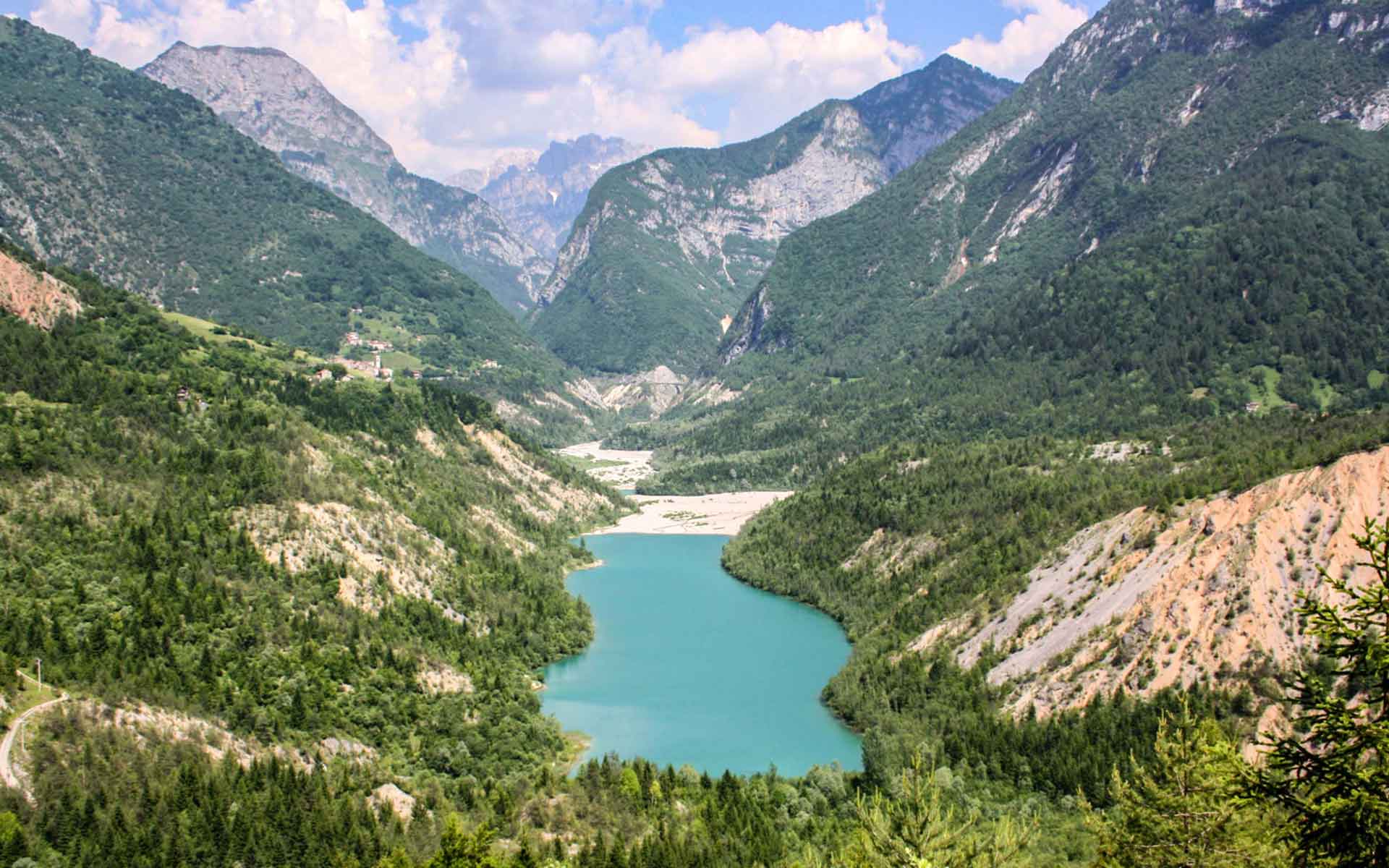
The extensive scarp and the huge body of the Vajont landslide detached from Mt. Toc (drone photo courtesy Monica Ghirotti).
Geological Period
Quaternary / Holocene
Main geological interest
Geomorphology and active geological processes
Engineering Geology
Location
Vajont valley (Eastern Italian Alps). Friuli Venezia Giulia, Italy
46°15’30.0″N, 12°20’31.0″E
The extensive scarp and the huge body of the Vajont landslide detached from Mt. Toc (drone photo courtesy Monica Ghirotti).
ONE OF THE MOST EMBLEMATIC AND BEST RESEARCHED LARGE LANDSLIDES WORLDWIDE KNOWN FOR ITS PECULIAR DYNAMICS AND CATASTROPHIC EFFECT.
The Vajont is one of the best researched landslide localities globally, and it has received regular attention from the scientific community during the last 60 years. It has a unique scientific importance, as the complex geology and mechanism of the landslide have been debated since the occurrence of the event, which was a turning point in the scientific knowledge of landslides. The wide scar and the enormous landslide body are still visible in their entire extent, and they indelibly mark the landscape of the valley. The site is easily accessible to visitors, who can also visit a memorial museum in Longarone, the first village to be destroyed. The Vajont can be considered an excellent example of a site of landslide geomorphology (Morino et al., 2022).
- Geological description
The Vajont landslide is a vast compound rock slide of approximately 270 million m3 of rock and debris detached from Mount Toc in 1963. It collapsed into a reservoir created by a 262 m high double curved arch dam built across the Vajont valley (Ghirotti, 2012). The movement mainly involved jointed limestone and marl of Jurassic and Cretaceous age, and it occurred along a M-shaped failure surface, which corresponds to a paleo-sliding surface (Semenza and Ghirotti, 2010). The impressive landslide body filled the reservoir in a few tens of seconds, causing the overflow of the dam and a 50 million m3 displacement wave that destroyed seven villages in the Piave River Valley, killing almost 2000 people. The dynamics of the initial stages of movement and of the final collapse are complex and still under debate (Selli et al., 1964; Hendron and Patton, 1985; Paronuzzi and Bolla, 2012), but the groundwater variations related to the reservoir water filling operation are considered as the most important triggering factors.
- Scientific research and tradition
The Vajont is one of the best-studied landslides in the world. The site is visited and studied by many scientists, and hundreds of articles have been published. A dedicated museum and many scientific and educational projects have been promoted in order to preserve the memory of the deadliest landslide event in Europe in recorded history.
Pre-1963 and post-1963 geological sections of the Vajont Valley (modified from Ghirotti, 2012). Legend: 1a: Quaternary; 1b: stratified alluvial gravels; 2: Flysch Formation; 3: Marls of Erto; 4: Scaglia Rossa Formation; 5a: Socchér Limestone Formation; 5b: Ammonitico Rosso and Fonzaso formations; 6: Vajont Limestone; 7: Igne Formation; 8: Soverzene Formation; 9: Dolomia Principale; 10: faults and overthrusts; 11: failure surface of the 1963 landslide.
- Reference
Ghirotti, M. (2012) ‘The 1963 Vaiont landslide, Italy. In: (a cura di): Clague J.J and Stead D., Landslides Types, Mechanisms and Modeling. p. 359-372, Cambridge University Press, ISBN: 9781107002067, doi: 10.1017/CBO9780511740367.030.’, in, pp. 359–372. Available at: https://doi.org/10.1017/CBO9780511740367.030.
Hendron, A.J. and Patton, F.D. (1987) ‘The vaiont slide — A geotechnical analysis based on new geologic observations of the failure surface’, Engineering Geology, 24(1), pp. 475–491. Available at: https://doi.org/10.1016/0013-7952(87)90080-9.
Morino, C., Coratza, P. and Soldati, M. (2022) ‘Landslides, a Key Landform in the Global Geological Heritage’, Frontiers in Earth Science, 10. Available at: https://www.frontiersin.org/articles/10.3389/feart.2022.864760.
Paronuzzi, P. and Bolla, A. (2012) ‘The prehistoric Vajont rockslide: An updated geological model’, Geomorphology, 169–170, pp. 165–191. Available at: https://doi.org/10.1016/j.geomorph.2012.04.021.
Selli, R. et al. (no date) ‘La Frana del Vajont’, Giornale di Geologia, 32(1), pp. 1-154 (in Italian).
Semenza, E. and Ghirotti, M. (2000) ‘History of the 1963 Vaiont slide: the importance of geological factors’, Bulletin of Engineering Geology and the Environment, 59(2), pp. 87–97. Available at: https://doi.org/10.1007/s100640000067.
- Author(s)
Department of Chemical and Geological Sciences, University of Modena and Reggio Emilia -International Association of Geomorphologists


